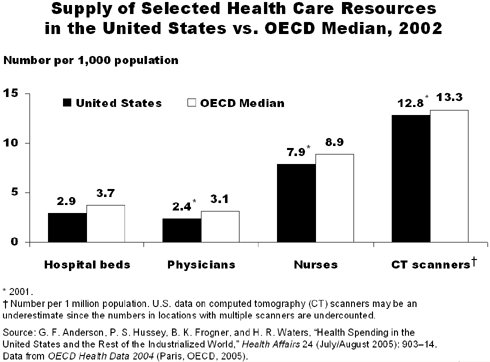While there is no question that the United States spends more than any other country on health care, observers and analysts often disagree about which factors are to blame and which strategies may slow the trend. However, a study published in Health Affairs, supported by The Commonwealth Fund, finds that higher prices for health services such as prescription drugs, hospital stays, and doctor visits, are the main reason for higher U.S. spending. The latest data from the Organization for Economic Cooperation and Development (OECD), which compare trends among 30 industrialized countries, show that the U.S. spent $5,267 per capita on health care in 2002—53 percent more than any other country.
In "Health Spending in the United States and the Rest of the Industrialized World" (Health Affairs, July/August 2005), Gerald F. Anderson, Peter S. Hussey, Bianca K. Frogner, and Hugh R. Waters of the Bloomberg School of Public Health at Johns Hopkins University, analyze the OECD data in an effort to determine why U.S. health spending is so much greater than that of other countries. They explore—and reject—two commonly proposed explanations: 1) other countries have restricted the supply of health care resources, which has led to waiting lists and lower spending; 2) the threat of malpractice litigation is much more common in the U.S., resulting in increased malpractice insurance premiums and the practice of "defensive medicine"—tests or procedures ordered by physicians to protect against the risk of being sued.
Role of Supply Constraints
Many OECD countries have relied on supply constraints to control health care spending, including limiting the number of hospital beds, controlling the spread of medical technology, and restricting the number of physicians. Does the lack of such constraints in the U.S. account for the vast spending differential? No, say the authors. Using U.S. survey data, they calculated the amount spent in the U.S. on the 15 procedures that represent the largest share of the waiting lists in Australia, Canada, and the United Kingdom. Total spending for these procedures was $21.9 billion, or only 3 percent of U.S. health spending in that year.
The authors also compared health spending in OECD countries with waiting lists to spending in those without lists. "Health spending in the twelve countries with waiting lists averaged $2,366 per capita," the authors say, "while in the seven countries without waiting lists, it averaged $2,696—both much less than U.S. spending of $5,267 per capita.
In a surprising finding, the authors discovered that, despite the lack of waiting lists, Americans do not have access to a greater supply of health care resources than people in most other OECD countries. In fact, the U.S. has fewer per capita hospital beds, physicians, nurses, and CT scanners than the OECD median. One area where the United States exceeded the OECD median was the nurse staffing level in acute care hospitals. In 2002, there were 1.4 nurses per U.S. hospital bed, compared with the OECD median of 1.0 nurses per bed.
Role of Malpractice Litigation
Another commonly cited contention is that medical malpractice litigation is driving up U.S. health spending. The authors compared malpractice claims data from the U.S., Australia, Canada, and the U.K., using information from national reports and databases. While the U.S. had 50 percent more malpractice claims filed per 1,000 population than the U.K. and Australia, and 350 percent more than Canada, payments were lower, on average, than those in Canada and the U.K. More important, average payments per capita were only $16 in the U.S. in 2001, compared with $12 in the U.K., $10 in Australia, and $4 in Canada. Including awards, legal fees, and underwriting costs, the total amount spent defending U.S. malpractice claims was an estimated $6.5 billion in 2001, or 0.46 percent of total health spending.
Defensive medicine could contribute more to health spending than malpractice payments do, but it is difficult to measure and estimates vary widely, say the authors. Even the upper estimate—9 percent, according to the U.S. Department of Health and Human Services—would explain only part of the higher U.S. health spending, they say.
Conclusions
If litigation and waiting lists cannot explain higher U.S. health spending, then what factors are responsible? Part of the difference can be attributed to higher U.S. incomes and cost of living. But the principal factor, say the authors, is higher medical care prices. Not only do they make health care unaffordable for many Americans, the extra dollars spent are not yielding demonstrably better quality of care or patient satisfaction. "Future U.S. policies should focus on the prices paid for health services," the authors say, "and on improving the quality of those services."
Facts and Figures
- In 2002, the United States spent $5,267 per capita on health care—53 percent more than Switzerland, the next-highest-spending country, and 140 percent more than the median OECD country.
- The number of hospital beds per capita in the U.S. was in the bottom quartile of OECD countries in 2002.
- In 2001, the average malpractice payment in the U.S. was $265,103, which was higher than Australia, but 14 percent below Canada and 36 percent below the United Kingdom.
